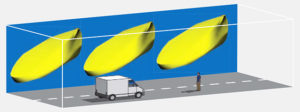What Is the Difference Between Symmetrical and Asymmetrical Lighting?
Symmetrical lights distribute light equally in all directions. Asymmetrical lights concentrate the light in one direction. This is the main difference between symmetrical and asymmetrical lighting. In indoor and outdoor lighting applications, it is extremely important to choose the right light distribution and angle in order to minimize glare, improve visual performance, prevent light pollution and provide homogeneous lighting.

Symmetrical lights distribute light equally in all directions. Asymmetrical lights concentrate the light in one direction. This is the main difference between symmetrical and asymmetrical lighting.
The uniform spread of light in all directions is ideal for general lighting of large areas and accent lighting (spotlights). Different types of lenses and reflectors are available to control light distribution, from very narrow to very wide angle.
Bright light can be directed at the desired angle in asymmetric light sources. Directing the light prevents the light from wasting in areas where it is not needed and prevents light pollution.
In applications such as road lighting, lighting fixtures are mounted on roadside poles and the light must be directed to illuminate the area where it is needed. Street lamps at the top of the poles can reflect all their light onto the road surface, even if they are parallel to the road surface. What makes this possible are asymmetric lenses specially developed for road lighting.
For example, an asymmetrical lens with an angle of 60*120 degrees will spread the light at an angle of 60 degrees along the width of the road and at an angle of 120 degrees along the road length. In this way, the distance between the poles will be increased and the number of poles and fixtures needed to illuminate the road will be reduced.
In addition to streets, asymmetric lights are used in stadiums, sports fields and theaters. The use of asymmetrical lights in such areas makes it possible for the audience to comfortably watch the event or the show without being disturbed by bright lights.
Although symmetrical lights are generally used for indoor lighting, asymmetric light distribution can also be used indoors. For example, if the reading light in a corner of the house has an asymmetrical distribution of light, it only illuminates the area needed and does not disturb other people in the room.
Light fixtures can be tilted to prevent irritating glare, or a visor can be used to hide the light source. Controlling the light by changing the direction of the luminaire can cause some of the light to be lost and cause glare.
Figure 1. Symmetrical lighting example
Figure 2. Asymmetrical lighting example
There are many types of lighting products with symmetrical and asymmetrical light distribution. In indoor and outdoor lighting applications, it is extremely important to choose the right light distribution and angle in order to minimize glare, improve visual performance, prevent light pollution and provide homogeneous lighting.








